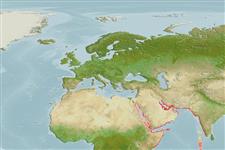Environment: milieu / climate zone / depth range / distribution range
Ecología
marino demersal; rango de profundidad 0 - 2 m (Ref. 10682). Tropical
Distribución
Países | Áreas FAO | Ecosistemas | Ocurrencias, apariciones | Point map | Introducciones | Faunafri
Western Indian Ocean: Persian Gulf to southern Oman.
Tamaño / Peso / Age
Maturity: Lm ? range ? - ? cm
Max length : 14.5 cm TL macho / no sexado; (Ref. 11441)
Espinas dorsales (total): 3 - 4; Radios blandos dorsales (total): 44-47; Espinas anales 1; Radios blandos anales: 36 - 39; Vértebra: 52 - 54. Females with an indistinct narrow dark stripe on body above lateral line and no black on anterior part of dorsal fin; males with a longitudinal row of 14 brown spots and 3 rows of small, dark edged, pale blue spots on body; dorsal and anal fins with a row of yellow dots on each membrane.
Feeds on zooplankton about half a meter above the sand substratum (Ref. 10682).
Life cycle and mating behavior
Madurez | Reproducción | Puesta | Huevos | Fecundidad | Larva
Randall, J.E. and A.B. Tarr, 1994. Trichonotus arabicus (Perciformes: Trichonotidae), a new species of sand diver from the Arabian Gulf and Oman. Fauna of Saudi Arabia 14:309-316. (Ref. 10682)
IUCN Red List Status (Ref. 130435)
Threat to humans
Harmless
Human uses
Más información
Nombres comunesSinónimosMetabolismoDespredadoresEcotoxicologíaReproducciónMadurezPuestaAgregación para la puestaFecundidadHuevosEgg development
Age/SizeCrecimientoLength-weightLength-lengthLength-frequenciesMorfometríaMorfologíaLarvaDinámica larvariaReclutamientoAbundanciaBRUVS
ReferenciasAcuiculturaPerfil de acuiculturaRazasGenéticaElectrophoresesheritabilidadEnfermedadesProcesamientoNutrientsMass conversion
ColaboradoresImágenesStamps, Coins Misc.SonidosCiguateraVelocidadTipo de nataciónSuperficie branquialOtolitosCerebrosVisión
Herramientas
Special reports
Download XML
Fuentes de Internet
Estimates based on models
Preferred temperature (Ref.
123201): 26.1 - 29.2, mean 27.7 °C (based on 298 cells).
Phylogenetic diversity index (Ref.
82804): PD
50 = 0.5020 [Uniqueness, from 0.5 = low to 2.0 = high].
Bayesian length-weight: a=0.00389 (0.00180 - 0.00842), b=3.12 (2.94 - 3.30), in cm total length, based on all LWR estimates for this body shape (Ref.
93245).
Nivel trófico (Ref.
69278): 3.4 ±0.45 se; based on food items.
Fishing Vulnerability (Ref.
59153): Low vulnerability (10 of 100).
